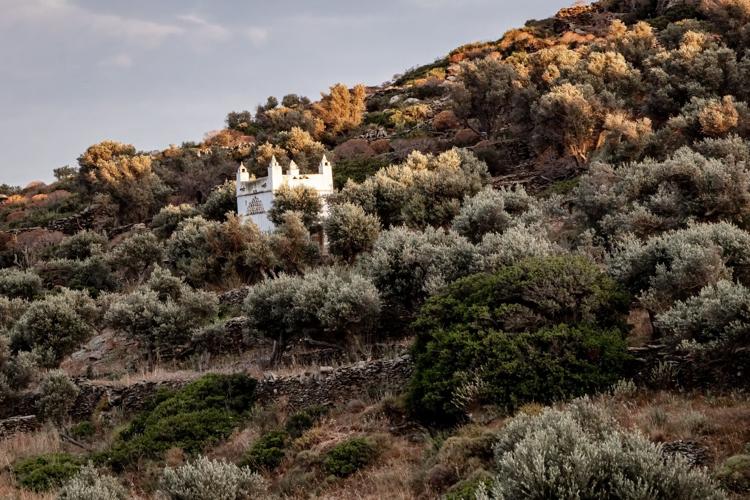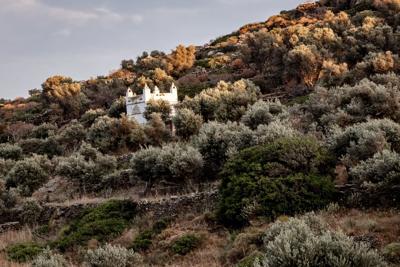Huffing and puffing, the May sun soaking my top with sweat, I lag behind my guide, Yannis Kourousis, as we climb the steep stone steps taking us out of a ravine on the Cycladic island of Sifnos.
Kourousis, a schoolteacher and founder of , is leading me along this ancient walking trail on the islandŌĆÖs east coast. WeŌĆÖd begun our hike in Kastro, where weŌĆÖd toured the remnants of the Venetian castle, and the labyrinthine streets of the medieval clifftop village and former island capital.
IŌĆÖve long enjoyed walking in nature, but IŌĆÖve always had difficulty with steep, rocky terrain, particularly after a bad fracture and two surgeries to my right leg more than a decade ago. Although I never fully recovered, in recent years IŌĆÖd made some strides ŌĆö receiving physiotherapy, for example, and doing regular exercises to strengthen my leg.

Yannis Kourousis, founder of Sifnos Walking Tours, leading the way down to Faros.
Elizabeth WarkentinThis trail, which finishes at the seafront Byzantine monastery of Chrysopigi, is the easiest hike that Kourousis offers. Still, the six kilometres of uneven terrain worries me. But my guide is patient and kind, supplying walking sticks, carrying extra water bottles and slowing his pace. IŌĆÖm determined to walk all the way to the end.
, a sleepy island where the roar of ATVs and motorcycles is rarely heard, sees far fewer travellers than its neighbours Mykonos, Santorini or even Milos. But in recent years, the island has been drawing more foodies and hikers looking for a quiet retreat. A web of ancient trails ŌĆö some of them were originally old donkey paths at least three millennia old ŌĆö criss-cross the rocky, mountainous landscape.
These footpaths, now a mapped network known as , have been revamped over the past decade. The municipality of Sifnos, in collaboration with the social co-operative enterprise , began restoration and waymarking in 2015. Today, Sifnos Trails spans 19 well-maintained footpaths, totalling more than 100 kilometres.

Sunset over an olive grove on the Greek island of Sifnos.
Elizabeth WarkentinAs Kourousis and I walk, late afternoon slips into early evening. We pass sloped terraced farms with winding stone walls; olive groves along with wild olive trees; crumbling peristeriones (the dovecote farm buildings so common here); and the white and blue chapels ubiquitous to the Cyclades.
Along the way, the air at times fragrant with wild thyme, marjoram or oregano, Kourousis stops to have me sniff shrubs or wildflowers. At one point he points out a caper bush, palming a pretty bloom with large white petals. ŌĆ£ItŌĆÖs common here for people to forage for capers to give flavour to many dishes,ŌĆØ he says. Caper bushes abound on this culinary island, the birthplace of celebrated chef and cookbook author Nikolaos Tselementes.
Eventually, we reach the coastline. Standing atop a long set of winding stone steps overlooking the quaint fishing village of Faros, we see in the near distance the whitewashed monastery of Panagia Chrysopigi, the patron saint and protector of Sifnos, resting on a rocky headland.

The view toward Chrysopigi from the quaint fishing village of Faros.
Elizabeth WarkentinŌĆ£The monastery was thought to be miraculous,ŌĆØ says Kourousis. According to local lore, nuns were living in the monastery during the Middle Ages. When pirates invaded, the nuns fled and went into hiding ŌĆö but one couldnŌĆÖt escape in time. She prayed to the Virgin Mary. ItŌĆÖs at this point, apparently, that the rock split in two and the pirates fell into the sea.
ŌĆ£If you look closely, youŌĆÖll see the rock is broken in two,ŌĆØ Kourousis continues. ŌĆ£The rear part of the monastery stands on a separate islet. ThereŌĆÖs a little pedestrian bridge joining the two parts of the headland.ŌĆØ
We walk down the winding stairs, made of honey-orange paving stones, past vegetable gardens and sugar white homes. Reaching the bottom, we cross the three beaches of Faros, past fetching beachfront restaurants and the heavenly BettyŌĆÖs Bakery.
At Glyfo beach, we climb the steps to the raised coastal path, the final part of the trail before reaching Apokofto beach and arriving at the miraculous monastery of Chrysopigi.

The writerŌĆÖs view upon arriving at the seafront Byzantine monastery of Chrysopigi.
Elizabeth WarkentinUltimately, our hike takes four and a half hours, instead of the suggested two to three, but IŌĆÖve achieved my goal. IŌĆÖve travelled the entirety of this trail on my own two feet. By the end, IŌĆÖm still walking without pain.
Taking in the panoramic views of the white monastery, the mountains around us and the sailboats bobbing on water in the pale blue twilight, I feel a sense of pride in my small yet significant accomplishment ŌĆö and wonder what I might hike next.





































To join the conversation set a first and last name in your user profile.
Sign in or register for free to join the Conversation